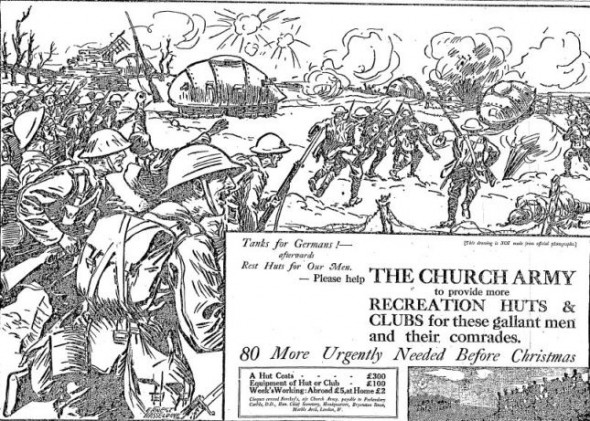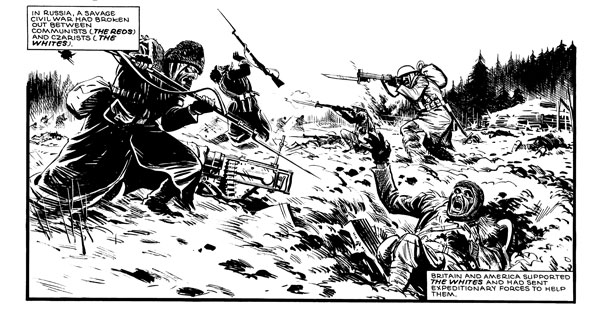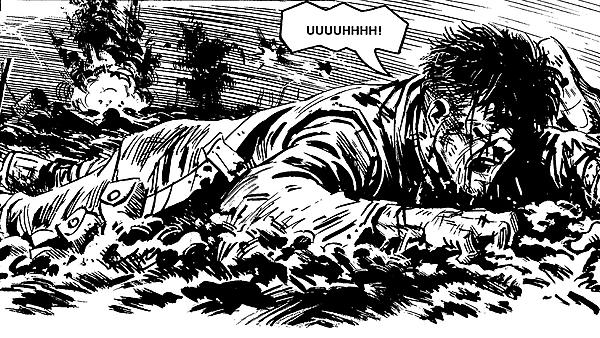John Freeman edited some of the Charley’s War collections for Titan Books and is also one of the editors of this Charley’s War web site. He’s worked in British comics for nearly 30 years, first at Marvel UK then as a freelance writer; at Titan Magazines; and for digital comics publisher ROK Comics. A freelance comics editor and writer, he’s also web master for the British comics news site downthetubes.net.
His World War One ancestor was a distant cousin, Noel Houghton Treleaven, who served in the West Yorkshire Regiment (Prince of Wales’s Own) and died on on 23rd November 1916, aged, it is believed, just 19.
“My mum’s been researching family history for many years, and recently came across this link to World War One,” says John. “I did as much digging as the Internet affords and have pieced together some more details of his life. It’s not much – I know there are people out there who have done an incredible amount of research and spent a lot of time trying to track down their family who were involved in the war. But It was an interesting challenge.
“Noel’s death was just one of many and it seems particularly cruel, given that based on his record, and his record of promotion to Second Lieutenant in August 1916, he had survived the horrors of the Somme brought to life so vividly in Charley’s War.”
The Life and Death of Noel Houghton Treleaven
Although buried in Hannescamps New Military Cemetery, Pas De Calais, France, he is listed on Kendal’s War Memorial as follows:
Second Lieutenant, 5th Battalion, West Yorkshire Regiment (Prince of Wales Own). Died 23rd November 1916. Aged 19. Rev W Woodman Treleaven and Ivah Selina Treleaven (Parents). Home town was Exeter. Buried/Commemorated Hannescamps New Military Cemetery
His father, the Reverend W. Woodman Treleaven, was a Wesleyan Minister. He is listed in the index of Methodist Ministers as being born in 1880, died 1918. He was it appears, briefly, a minister in Keswick (PDF link), which notes that “the Rev. W. Woodman Treleaven had been invited to the circuit as Superintendent in 1918, but he died shortly before he could take up the appointment, and Conference designated his son-the Rev. Woodman Treleaven. M.A. to fill the vacancy for one year; Mr. Treleaven, despite his short stay was not forgotten in the circuit, and he returned as Superintendent in 1936.”
His mother’s maiden name was Quick.
Although they came from Exeter, Noel was educated at Kingswood School, Bath. His parents appear to have moved to Cumbria to follow his father’s ministry.
We don’t know when he joined the Regiment, or whether it was as a volunteer or conscript. The London Gazette (PDF link) notes that he was promoted from cadet to Second Lieutenant on 5th August 1916.
The Battle of the Somme had ended by the time of his death. Like many other victims of the war, was singularly unlucky: there isn’t a battle listed for the day Noel died at Souastre, which is on the Doullens-Arras Road. The West Yorkshire Regiment in the War 1914-1918 Volume 1 lists just 14 casualties of the 5th Battalion during the war and he’s the only one to have died that day – of the casualties, many were “Second Lieutenants”.
The book suggests that although the Brigade was not in battle when Noel died, they came under frequent shell fire and sniper attack.
The start of the book is here (which makes for grim reading but offers the detached view that the Battle of the Somme “achieved its objective”.
One of JRR Tolkein’s compatriots died in similar circumstances there on 29th November (http://www.webmatters.net/txtpat/?id=107).
Noel died on the day after the author Jack London and on the same day that Major L.G. Hawker VC, DSO was killed in a dogfight with Baron Manfred von Richtofen (the ‘Red Baron’).
He would have qualified for two medals – both posthumous.
Like many service personnel of World War One, he was (posthumously) entitled to the Victory Medal, also called the Inter Allied Victory Medal. This medal was awarded to all who received the 1914 Star or 1914-15 Star and, with certain exceptions, to those who received the British War Medal. It was never awarded alone. When these three medals were issued in the 1920s they were sometimes irreverently referred to as Pip, Squeak and Wilfred, after the hugely-popular Daily Mirror comic strip characters of the period.
(Pip, Squeak and Wilfred was written by Bertram J. Lamb (Uncle Dick), and drawn by the cartoonist Austin Bowen Payne (A.B. Payne). Pip was the dog, Squeak the penguin and Wilfred the young rabbit and the strip often pitted the heores against Bolshevik spies armed with bombs as well as offering more domestic humour. It is believed that Payne’s batman during the war had been nicknamed “Pip-squeak” and this is where the idea for the names of the dog and penguin came from. For some reason the three names of the characters became associated with the three campaign medals being issued at that time to many thousands of returning servicemen, and they stuck).
Eligibility for this award consisted of having been mobilised, fighting, having served in any of the theatres of operations, or at sea, between midnight 4th/5th August, 1914, and midnight, 11th/12th November, 1918. Women who served in any of the various military organisations in a theatre of operations were also eligible.
As with many Armed Forces personnel, Noel was also entitled to the British War Medal for service in World War One. This British Empire campaign medal was issued for services between 5th August 1914 and 11th November 1918. The medal was automatically awarded in the event of death on active service before the completion of this period.
The West Yorkshire Regiment
Over the entire conflict, the West Yorkshire Regiment, based in York, raised 35 Battalions and was awarded 57 Battle Honours and 4 Victoria Crosses, losing 12,700 men. The Forces Records site has this information on the 5th Battalion (http://www.forces-war-records.co.uk/unit-info/3532)
Numerous battalions of the Regiment served at Neuve-Chappelle, Loos, the Somme, Passchendaele, Ypres, Marne, Arras, Cambrai and Gallipoli. At its peak The West Yorkshire Regiment numbered 37 battalions, 66 Battle Honours were bestowed and four Victoria Crosses were awarded.
Four Territorial Force battalions formed the West Yorkshire Brigade (which mobilised as 146 Brigade, 49th (West Riding) Infantry Division on the outbreak of World War I and served in France 1915–18. They raised duplicate battalions (2/5th, 2/6th, 2/7th, 2/8th) that constituted 185 Bde in 62nd (2nd West Riding) Division, which also served in France 1917–18.
In 1915 they formed further reserve battalions (3/5th, 3/6th, 3/7th, 3/8th) that served in the British Isles.
The Fifth Battalion (to which Noel belonged) was part of the 49th (West Riding) Infantry Division, 146th Brigade which was given the White Rose of York as its insignia.
The Brigade comprised Noel’s 1/5th Battalion (6 officers and 103 Ordinary Recruits) and the 1/6h (6 Officers and 235 ordinary recruits), 1/7th (12 Officers, 529 O/Rs) and 1/8th ( officers, 294 O/Rs) – all from the West Yorkshire Regiment.
The West Riding Division was a formation of the Territorial Force. It was formed as a result of the reforms of the army carried out in 1908 under the Secretary of State for War, Richard Burdon Haldane and was one of 14 Divisions of the peacetime Territorial Force.
The units of the Division had just departed for annual summer camp in 1914 when emergency orders recalled them to the home base. All units were mobilised for full time war service on 5 August 1914 and moved to concentrate in the South Yorkshire / Lincolnshire area by mid August 1914.
1914
4th August 1914: The 1/5th stationed at York, the 1/6th were stationed at Bradford and the 1/7th stationed at Leeds, all as part of the 1st West Riding Brigade of the West riding Division then moved to Selby and then Strensall and back to York.
1915
31st March 1915: The Division was warned that it would go on overseas service and moved to Gainsborough.
12th April: Entrainment begins
15th April: Mobilised for war, the Divisional infantry went via Folkestone-Boulogne while all other units went from Southampton to Le Havre.
19th April: The Division had concentrated in the area of Estaires – Merville – Neuf Berquin. The Division then remained in France and Flanders and took part in the following engagements:
9th May: The Battle of Aubers Ridge
15th May: Formation became the 146th Brigade of the 49th Division which engaged in various actions on the Western Front including;
19th December: The defence against the first Phosgene attack
1916
1 – 13th July: The Somme – The Battle of Albert, including the capture of Montauban, Mametz, Fricourt, Contalmaison and La Boisselle
14 – 17th July: The Somme – The Battle of Bazentin Ridge, including the capture of Longueval, Trones Wood and Ovillers
5th August: Noel promoted from cadet to Second Lieutenant on 5th August 1916 (PDF link, London Gazette)
15th July – 3rd September: The Somme – The Battle of Pozieres Ridge Phase (15 July – 3 September), including the fighting for Mouquet Farm
15th – 22nd September: The Somme – The Battle of Flers-Courcelette, including the capture of Martinpuich
This first battle to see the use of tanks (the London press advertisement below appeared on 12 October 1916, just a few weeks later. The cartoonist had clearly never seen a tank but did his best!). Noel might have been involved in the Attack on the Schwaben Redoubt in early September.
23rd November: Noel is killed at Souastre. War diaries found online (including those of Martin Goodman and Alfred Mills) suggest shelling and sniper fire were dangers here.
29th November: In the aftermath of the Battle of the Somme, JRR Tolkein’s friend Geoffrey Smith was acting as Adjutant and camped near Souastre. The Battalion was shelled and Smith was hit by shrapnel. By 2nd December his wounds to his right arm were considered dangerous and at 0330 hours the following morning, he died. (Source)
1917
Operations on the Flanders Coast (Hush), The Battle of Poelcapelle.
1918
The Battle of Estaires, The Battle of Messines, The Battle of Bailleul, The First Battle of Kemmel Ridge, The Second Battle of Kemmel Ridge, The Battle of the Scherpenberg, The pursuit to the Selle, The Battle of the Selle, The Battle of Valenciennes.
11th November: Ended the war at Evin-Malmaison north of Douai, France.
First published on the Charley’s War web site
One of many guest posts for downthetubes.
Categories: Charley's War, Features


 Curating Charley’s War: An Interview with Titan’s collection editor Simon Ward
Curating Charley’s War: An Interview with Titan’s collection editor Simon Ward  Charley’s War “Micro Site” joins DownTheTubes
Charley’s War “Micro Site” joins DownTheTubes  Looking back on Charley’s War: An Interview with Pat Mills
Looking back on Charley’s War: An Interview with Pat Mills